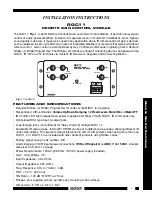
258
Configuring IPsec
The term "interface" in this chapter collectively refers to Layer 3 interfaces, including VLAN
interfaces and Layer 3 Ethernet interfaces. You can set an Ethernet port as a Layer 3 interface by
using the
port link-mode route
command (see
Layer 2—LAN Switching Configuration Guide
).
CAUTION:
ACLs for IPsec take effect only on traffic that is generated by the device and traffic that is destined
for the device. They do not take effect on traffic forwarded through the device.
Overview
IP Security (IPsec) is defined by the IETF to provide interoperable, high-quality,
cryptographically-based security for IP communications. It is a Layer 3 VPN technology that
transmits data in a secure channel established between two endpoints (such as two security
gateways). Such a secure channel is usually called an IPsec tunnel.
IPsec is a security framework that has the following protocols and algorithms:
•
Authentication Header (AH).
•
Encapsulating Security Payload (ESP).
•
Internet Key Exchange (IKE).
•
Algorithms for authentication and encryption.
AH and ESP are security protocols that provide security services. IKE performs automatic key
exchange. For more information about IKE, see "Configuring IKE."
IPsec provides the following security services for data packets in the IP layer:
•
Confidentiality
—The sender encrypts packets before transmitting them over the Internet,
protecting the packets from being eavesdropped en route.
•
Data
integrity
—The receiver verifies the packets received from the sender to make sure they
are not tampered with during transmission.
•
Data origin authentication
—The receiver verifies the authenticity of the sender.
•
Anti-replay
—The receiver examines packets and drops outdated and duplicate packets.
IPsec delivers the following benefits:
•
Reduced key negotiation overhead and simplified maintenance by supporting the IKE protocol.
IKE provides automatic key negotiation and automatic IPsec security association (SA) setup
and maintenance.
•
Good compatibility. You can apply IPsec to all IP-based application systems and services
without modifying them.
•
Encryption on a per-packet rather than per-flow basis. Per-packet encryption allows for
flexibility and greatly enhances IP security.
Security protocols and encapsulation modes
Security protocols
IPsec comes with two security protocols, AH and ESP. They define how to encapsulate IP packets
and the security services that they can provide.
•
AH (protocol 51) defines the encapsulation of the AH header in an IP packet, as shown
in
. AH can provide data origin authentication, data integrity, and anti-replay services
















































